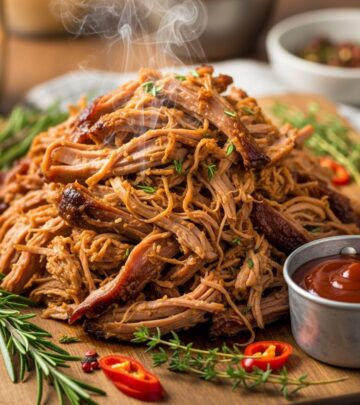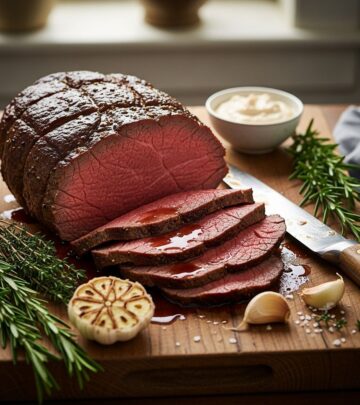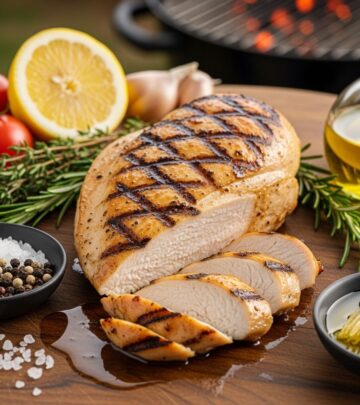Beyond Curry: The Irresistible Indian Masala Omelet
A customizable egg dish that brings bold spice blends and fresh herbs to any meal.

If there is a dish that captures both the robust flavor of Indian home kitchens and the dynamic allure of street food stalls, it’s the masala omelet. This spicy, herb-packed egg dish is more than just a breakfast staple; it’s an emblem of adaptability, tradition, and bold, everyday satisfaction. Whether you’re serving it rolled in roti, tucked into buttered toast, or devouring it straight from the skillet, the Indian masala omelet is poised to become the MVP of your breakfast repertoire.
What Is a Masala Omelet?
The masala omelet (sometimes spelled “masala omelette”) is a classic Indian dish rooted in both home and street food culture. At its core, it’s a fluffy omelet jazzed up with the flavors of finely chopped onions, chilies, fresh cilantro, and ground spices such as turmeric, chili powder, and garam masala. While its precise form varies regionally, a few key elements remain constant: bright heat, a fresh herbal note, and the golden glow of deeply spiced eggs.
- Origin: Enjoyed across India, often as morning sustenance or a late-night street snack.
- Serving Styles: Folded in buttered toast, rolled inside chapati, or plated solo with chutney or ketchup.
- Key Character: Herbaceous, spicy, crisp at the edges but tender within.
Tracing the Roots: Street Food to Home Kitchen
Unlike the sophisticated French omelet, the Indian masala omelet is defined more by improvisation than fussy technique. You’ll find it in nearly every canteen, roadside stall, and busy station platform across India. Vendors crack eggs into a bowl, beat them vigorously with chopped onion, green chili, and coriander before pouring the fiery mixture into smoking-hot pans. In minutes, the eggs puff up, flecked with charred bits of spice and herb—a symphony of aroma and texture.
At home, masala omelets are a beloved breakfast, especially for busy families. They’re quick, nourishing, and infinitely adaptable: what’s in the fridge goes into the mix. Many home cooks recall their parents, often mothers, making them as a gesture of comfort and quick nourishment—a taste of care nestled between slices of toast or folded into a tiffin box.
Key Ingredients and Regional Variations
The beauty of a masala omelet lies in its template-like simplicity. While you’ll always find eggs, onions, and some combination of chilies and coriander, the rest varies by taste and region. Here’s a look at the essentials:
| Ingredient | Purpose | Common Variations |
|---|---|---|
| Eggs | Base; provides richness and structure | Duck, quail, or free-range eggs for special occasions |
| Onion | Crunch, sweetness, bulk | Red, white, or yellow onions, sometimes even shallots |
| Fresh Green Chilies | Heat and aroma | Mild to fiery; deseeded for less spice |
| Cilantro (Coriander) | Herbaceous, cooling lift | Parsley or mint for variation |
| Tomato (optional) | Moisture and tang | Chopped fresh or omitted entirely |
| Spices | Color, flavor, depth | Paprika, Kashmiri chili powder, black pepper for tweaks |
Regional tweaks: In southern India, curry leaves or chopped green mango may appear; in Punjab, more garam masala or ground coriander is used. Some cooks add bits of bell pepper, cheese, or even leftover meat, channeling the masala omelet’s inherent versatility.
Healthful and Adaptable: Why Eat a Masala Omelet?
The masala omelet isn’t just about flavor; it’s a nutritional powerhouse. Eggs provide high-quality protein and healthy fats. The spices and fresh aromatics, including turmeric and coriander, pack antioxidant and anti-inflammatory properties. Chopped vegetables and herbs add vitamins, and it’s naturally gluten-free when served solo or with gluten-free sides.
- Rich in protein: Great choice for breakfast or a filling lunch
- Good source of fiber: When made with extra veggies
- Low in carbs: Satisfying for low-carb diets
Cooking the Perfect Masala Omelet: Step-by-Step Guide
Making a masala omelet is blissfully straightforward, but attention to detail transforms it from good to unforgettable. Here’s a standard method that delivers a fluffy, golden result every time.
- Prep all ingredients: Finely chop onion, green chilies, tomato, and fresh cilantro. Crack eggs into a mixing bowl.
- Add spices: Sprinkle in turmeric, chili powder, garam masala, a little salt, and black pepper. If you like, add a pinch of cumin powder for extra warmth.
- Whisk vigorously: Beat egg and mix-ins until frothy. This incorporates air, resulting in a fluffier omelet.
- Heat oil or ghee: Warm a nonstick or well-seasoned skillet over medium-high heat. Add a little neutral oil or ghee; some prefer butter for a rich flavor.
- Pour and swirl: Pour the egg mixture in and quickly swirl to spread it out. Use a spatula to push the cooked edges to the center, letting uncooked egg flow outward.
- Cook until set: Allow one side to brown slightly and the edges to get crisp. Flip carefully (or leave open-faced), cooking the other side briefly. The interior should remain a touch custardy, not dry.
- Serve hot: Slide onto a plate, fold if desired, and finish with a squeeze of lemon.
Serve with:
- Buttered white bread or soft rolls
- Roti or paratha
- Ketchup or spicy chutney
- Fresh salad or sliced cucumbers
Ingredient Swaps and Modern Variations
One of the joys of the masala omelet is how readily it welcomes substitution:
- Dairy: Add cheese (crumbled feta, cheddar, or paneer) for a melting surprise.
- Vegetables: Throw in peas, bell peppers, or wilted spinach for color and nutrients.
- Meat: Fold in diced cooked ham, sausage, or shredded chicken for a non-vegetarian version.
- Flavor boosters: Sprinkle chaat masala on top before serving, or stir in a spoonful of kasundi (Bengali mustard sauce) for depth.
- Herb twist: Replace cilantro with fresh dill or mint for a different taste profile.
Tips and Tricks for Mastery
- Use fresh herbs: Fresh coriander or cilantro brings essential brightness.
- Don’t skimp on spice: A little heat defines the masala omelet. Adjust chili levels to preference.
- Beat eggs well: Aerating the mixture yields the desired fluffiness.
- Let veggies sweat: If you have time, sauté onions and chilies for a minute before adding eggs; this intensifies flavor.
- Serve immediately: A masala omelet is best hot from the pan, when edge-crisp and inner-tenderness contrast perfectly.
Pairings: What to Eat with a Masala Omelet
Beyond its obvious pairing with toast or roti, the masala omelet makes a versatile companion:
- Breakfast sandwich: Sandwich the omelet between buttered slices of milk bread with a touch of ketchup or green chutney.
- Wrap: Roll it up inside warm paratha or chapati with a slather of pickle and sliced onions.
- Side: Add to a thali (platter) alongside dal, rice, and sabzi for an unexpected boost of protein.
The Complete Masala Omelet Recipe
Ready to bring the Indian masala omelet home? Here’s a tried-and-true basic recipe, ready for adaptation:
Ingredients (serves 2)
- 4 large eggs
- 1 small red onion, finely chopped
- 1 small tomato, diced (optional)
- 2 green chilies, finely chopped (adjust to taste)
- 2 tablespoons fresh cilantro (coriander), chopped
- 1/2 teaspoon turmeric powder
- 1/2 teaspoon ground chili powder
- 1/4 teaspoon garam masala
- Salt and black pepper, to taste
- 1-2 tablespoons neutral oil, ghee, or butter
- Lemon wedge, to serve
Instructions
- In a mixing bowl, beat eggs with onions, tomatoes, chilies, cilantro, turmeric, chili powder, garam masala, salt, and pepper until frothy.
- Heat oil or ghee in a skillet over medium heat. Add the egg mixture, spreading it evenly across the pan. Cook for 1-2 minutes until the edges set and the center is mostly set.
- Flip carefully using a spatula. Cook for another minute until lightly browned and cooked through, but still tender.
- Slide onto a plate, squeeze a little lemon on top, and serve immediately, alongside toast, roti, or as is.
History and Cultural Significance
Eggs are not central to traditional vegetarian Indian cuisine, but the masala omelet survives as an urban phenomenon—street food, railway stall, and family kitchen alike. Its popularity owes much to British colonial influence, which introduced the Western concept of omelets to colonial kitchens. Indian cooks, characteristically, adapted it with a riot of local flavors and spices. Over time, the masala omelet outgrew its roots as a “continental” hotel breakfast to become a true cross-cultural staple—sometimes paired with toast and ketchup (a nod to British tastes), more often enjoyed as a spicy, aromatic meal on the move.
The dish’s enduring presence on Indian railway platforms, where porters slap together fresh omelets for travelers, has made it an icon of practical, everyday luxury. For many, it’s a nostalgic pleasure—redolent of hurried mornings, nourishing tiffins, reunions, and comforting routines.
Masala Omelet: Global Interpretations
With the spread of Indian cuisine, the masala omelet’s flavors have traveled. From London’s trendy brunch cafes serving masala omelets with avocado and sourdough, to New York delis spiking theirs with extra turmeric, it has become an ambassador for India’s approach to humble ingredients: take the everyday, and transform it with spice, care, and a hint of surprise.
Frequently Asked Questions (FAQs)
Q: Is the masala omelet always spicy?
A: No—the heat can be easily adjusted by reducing or removing green chilies or chili powder. The other spices contribute flavor more than heat.
Q: Can I make the omelet in advance?
A: While best served fresh and hot, cooked omelets can be refrigerated and quickly reheated in a skillet or microwave. Texture is best when made to order.
Q: Are there vegetarian or vegan versions?
A: The base is vegetarian (contains eggs). For a vegan version, chickpea flour “omelets” (called besan chilla) can be spiced and cooked in the same style.
Q: What’s the best side dish?
A: Classic pairings include buttered white bread, roti, and a simple salad or chutney. Feel free to experiment with global sides.
Q: Can I use other spices?
A: Yes—the masala omelet is a canvas. Try cumin, fennel seeds, smoked paprika, or your own favorite spice mixes.
Final Thoughts
The Indian masala omelet is much more than an egg dish—it’s a celebration of adaptation, comfort, and the transformative power of everyday ingredients. Let it be the gateway to a more vibrant breakfast, an impromptu dinner, or the dish that makes you fall in love with eggs all over again.
References
Read full bio of medha deb












